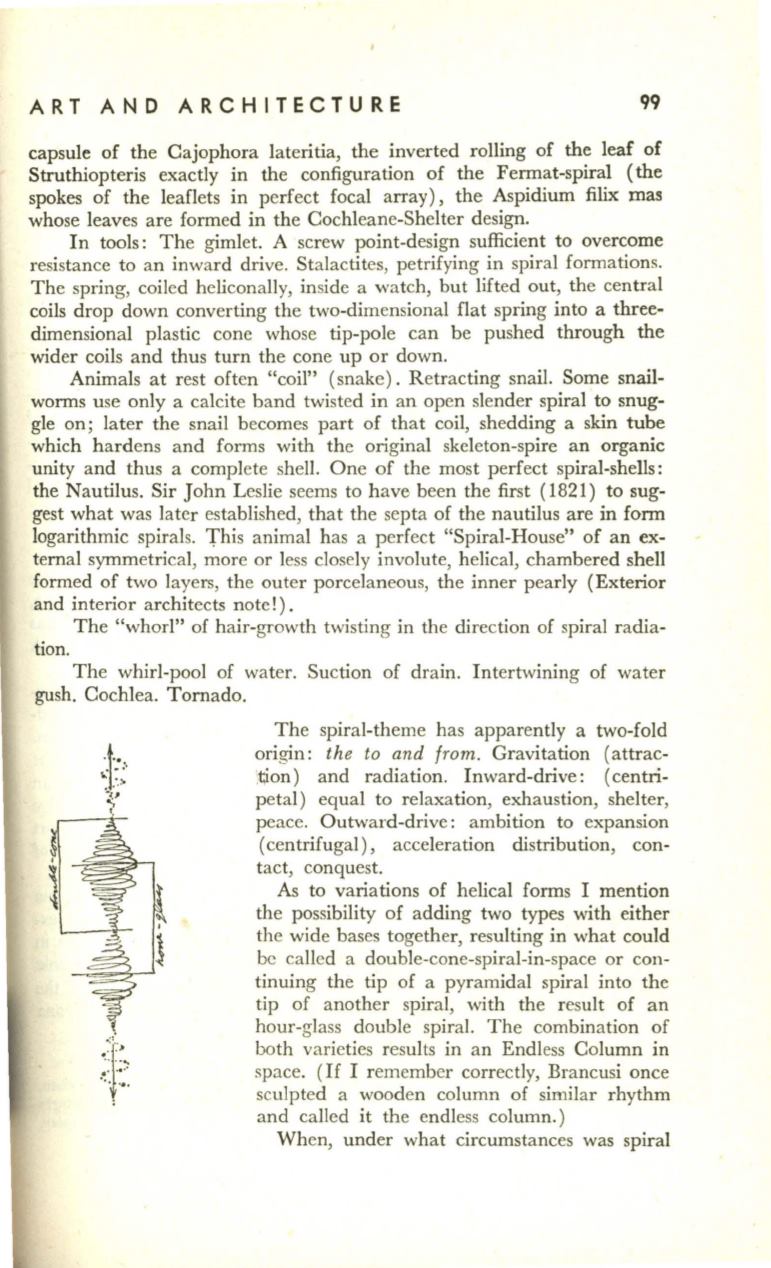
ART AND ARCHITECTURE
99
capsule of the Cajophora lateritia, the inverted rolling of the
leaf of
Struthiopteris exactly in the configuration of the Fermat-spiral (the
spokes of the leaflets in perfect focal array), the Aspidium filix mas
whose leaves are formed in the Cochleane-Shelter design.
In tools: The gimlet. A screw point-design sufficient to overcome
resistance to an inward drive. Stalactites, petrifying in spiral formations.
The spring, coiled heliconally, inside a watch, but lifted out, the central
coils drop down converting the two-dimensional flat spring into a three–
dimensional plastic cone whose tip-pole can be pushed through the
wider coils and thus turn the cone up or down.
Animals at rest often "coil" (snake) . Retracting snail. Some snail–
worms use only a calcite band twisted in an open slender spiral to snug–
gle on; later the snail becomes part of that coil, shedding a skin tube
which hardens and forms with the original skeleton-spire an organic
unity and thus a complete shell. One of the most perfect spiral-shells:
the Nautilus. Sir John Leslie seems to have been the first ( 1821) to sug–
gest what was later established, that the septa of the nautilus are in form
logarithmic spirals. This animal has a perfect "Spiral-House" of an ex–
ternal symmetrical, more or less closely involute, helical, chambered shell
formed of two layers, the outer porcelaneous, the inner pearly (Exterior
and interior architects note!).
The "whorl" of hair-growth twisting in the direction of spiral radia–
tion.
The whirl-pool of water. Suction of drain. Intertwining of water
gush. Cochlea. Tornado.
:'i'·:·
~-
....
(
·~~~
The spiral-theme has apparently a two-fold
origin:
the to and from.
Gravitation (attrac–
,t;ion) and radiation. Inward-drive: (centri–
petal) equal to relaxation, exhaustion, shelter,
peace. Outward-drive: ambition to expansion
(centrifugal), acceleration distribution, con–
tact, conquest.
As
to variations of helical forms I mention
the possibility of adding two types with either
the wide bases together, resulting in what could
be called a double-cone-spiral-in-space or con–
tinuing the tip of a pyramidal spiral into the
tip of another spiral, with the result of an
hour-glass double spiral. The combination of
both varieties results in an Endl ess Column in
space.
(If
I remember correctly, Brancusi once
sculpted a wooden column of similar rhythm
and called it the endless column.)
When, under what circumstances was spiral


